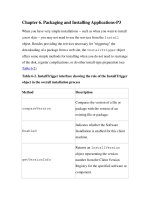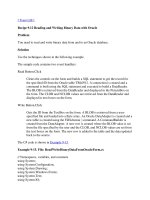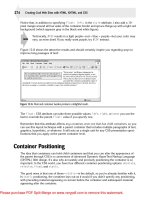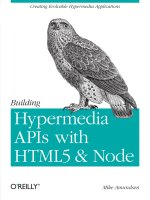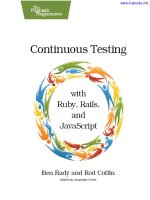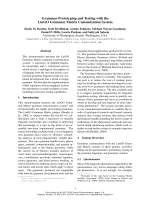Building and Testing with Gradle pdf
Bạn đang xem bản rút gọn của tài liệu. Xem và tải ngay bản đầy đủ của tài liệu tại đây (5.54 MB, 110 trang )
www.it-ebooks.info
www.it-ebooks.info
Building and Testing with Gradle
www.it-ebooks.info
www.it-ebooks.info
Building and Testing with Gradle
Tim Berglund and Matthew McCullough
foreword by Gradleware CTO Ken Sipe
Beijing
•
Cambridge
•
Farnham
•
Köln
•
Sebastopol
•
Tokyo
www.it-ebooks.info
Building and Testing with Gradle
by Tim Berglund and Matthew McCullough
Copyright © 2011 Gradle, Inc All rights reserved.
Printed in the United States of America.
Published by O’Reilly Media, Inc., 1005 Gravenstein Highway North, Sebastopol, CA 95472.
O’Reilly books may be purchased for educational, business, or sales promotional use. Online editions
are also available for most titles (). For more information, contact our
corporate/institutional sales department: (800) 998-9938 or
Editors: Mike Loukides and Meghan Blanchette
Production Editor: Jasmine Perez
Proofreader: Jasmine Perez
Cover Designer: Karen Montgomery
Interior Designer: David Futato
Illustrator: Robert Romano
Printing History:
July 2011: First Edition.
Nutshell Handbook, the Nutshell Handbook logo, and the O’Reilly logo are registered trademarks of
O’Reilly Media, Inc. Building and Testing with Gradle, the image of a bush wren, and related trade dress
are trademarks of O’Reilly Media, Inc.
Many of the designations used by manufacturers and sellers to distinguish their products are claimed as
trademarks. Where those designations appear in this book, and O’Reilly Media, Inc. was aware of a
trademark claim, the designations have been printed in caps or initial caps.
While every precaution has been taken in the preparation of this book, the publisher and authors assume
no responsibility for errors or omissions, or for damages resulting from the use of the information con-
tained herein.
ISBN: 978-1-449-30463-8
[LSI]
1309457128
www.it-ebooks.info
To my son, Zach, who plays the trumpet
Psalm 150:3
—Tim Berglund
This book is dedicated to my entire extended family
who, in numerous ways, facilitated the creation of
this first of many books. To my beautiful and
supportive wife Madelaine for allowing me long
nights of typing and days of constant Gradle talk.
My daughters Scarlette and Violette for playing
rounds of Angry Birds while I made on-the-road
commits to the book. My brother Jordan for
promoting Gradle in his circle of Denver developers
and supporting my photographic imagery
needs in Gradle educational materials. And my
parents Terry and Marylyn for bearing the laptop
coming out even at dinner whenever a few more
paragraphs could be composed.
—Matthew McCullough
www.it-ebooks.info
www.it-ebooks.info
Table of Contents
Foreword . . . . . . . . . . . . . . . . . . . . . . . . . . . . . . . . . . . . . . . . . . . . . . . . . . . . . . . . . . . . . . . . . . . xi
Preface . . . . . . . . . . . . . . . . . . . . . . . . . . . . . . . . . . . . . . . . . . . . . . . . . . . . . . . . . . . . . . . . . . . . xiii
1. Hello, Gradle! . . . . . . . . . . . . . . . . . . . . . . . . . . . . . . . . . . . . . . . . . . . . . . . . . . . . . . . . . . 1
Build Files in Groovy 2
Domain-Specific Build Languages 2
Getting Started 3
MacOS Installation with Brew 4
Linux and MacOS Installation 4
Windows Installation 4
The Hello World Build File 6
Building a Java Program 8
The Gradle Command Line 10
2. Gradle Tasks . . . . . . . . . . . . . . . . . . . . . . . . . . . . . . . . . . . . . . . . . . . . . . . . . . . . . . . . . . 13
Declaring a Task 13
Task Action 14
Task Configuration 15
Tasks Are Objects 16
Methods of DefaultTask 17
Properties of DefaultTask 22
Dynamic Properties 26
Task Types 27
Copy 27
Jar 27
JavaExec 28
Custom Task Types 29
Custom Tasks Types in the Build File 29
Custom Tasks in the Source Tree 31
Where Do Tasks Come From? 32
vii
www.it-ebooks.info
Conclusion 33
3. Ant and Gradle . . . . . . . . . . . . . . . . . . . . . . . . . . . . . . . . . . . . . . . . . . . . . . . . . . . . . . . . 35
The Vocabulary 35
Hello Ant 37
Importing Custom Ant Tasks 38
Complex Ant Configuration 40
Importing an Entire Ant Build File 41
Ant Target and Gradle Task Codependence 42
Using AntBuilder 43
A Harmonic Duo 46
4. Maven and Gradle . . . . . . . . . . . . . . . . . . . . . . . . . . . . . . . . . . . . . . . . . . . . . . . . . . . . . . 47
Cue Graven? 47
The Maven POM and Gradle Build 48
Maven Goals, Gradle Tasks 50
The Standard Maven Coordinates, Gradle Properties 51
More Gradle Properties 52
Dependencies 55
Repositories 57
Unit Testing 59
Multiple Source Directories 61
Default Tasks 61
The Maven Plug-in 62
Installing to the Local Maven Repository (Cache) 63
Publishing to a Maven Repository 64
Maven2Gradle Build Script Converter 65
Maven POM Import 67
Conclusion 68
5. Testing with Gradle . . . . . . . . . . . . . . . . . . . . . . . . . . . . . . . . . . . . . . . . . . . . . . . . . . . . 69
JUnit 69
TestNG 72
Spock 73
Geb and EasyB 74
Gradle’s Testing Focus 77
6. Multiproject Builds . . . . . . . . . . . . . . . . . . . . . . . . . . . . . . . . . . . . . . . . . . . . . . . . . . . . . 79
Multiproject Build Structure 79
Project-Specific Build Files 80
One Master Build File 83
A Hybrid Multiproject Build 84
Individual, Unified, or Hybrid? 85
viii | Table of Contents
www.it-ebooks.info
Multiproject Task Structure 86
Multiple Projects Your Way 87
Table of Contents | ix
www.it-ebooks.info
www.it-ebooks.info
Foreword
When I started writing Java code in 1996, there weren’t many options for compiling
and building a project outside of javac and a custom build script. In those days, many
of us with a background in C configured makefiles to build Java, because that’s what
we knew. The challenge with this approach was that the idiom of make and the model
it defined didn’t reflect the Java world very well. Many teams would resort to creating
a shell or batch script to build their project, so there was a huge vacuum at this time
for a tool that would provide platform independent building and packaging. The first
tool to provide a successful solution to this problem and to realize significant adoption
was Ant. Ant provided a way to describe a Java build that was extensible and platform
independent, which was a large part of its success. Some of the downsides of Ant were
its verbosity, its lack of conventions, and its lack of dependency management. These
deficiencies led to another popular tool, Maven, to be adopted by a number of devel-
opment teams.
During the same timeframe, the industry’s maturity was growing in the area of software
engineering discipline. Many of these disciplines were captured in the Agile Manifesto
and in the spirit of Extreme Programming. These led to many changes, including more
frequent builds on machines other than the developer’s workstation, often on different
operating systems. Many teams discovered that a successful compile was just a small
measure of the quality of a project, leading to an increased demand on the build system,
including unit and integration testing, static analysis tools such as FindBugs, and code
coverage analysis. This resulted in new build system pain points that needed to be
addressed. Instead of revisiting the model of the build tool, the common solution was
to create plug-ins to existing build systems. The continued growth in software engi-
neering maturity today can be seen in the DevOps movement, climaxing with the pub-
lication last year of Jez Humble and David Farley’s book Continuous Delivery ( A d d i s o n -
Wesley). The discipline of continuous delivery encourages us to ask: how fast can we
move a newly coded idea from development into production? The solution to the chal-
lenges of continuous delivery is automation.
What I have discovered over the years as a software engineer is that in order to solve a
problem best, I have to understand the model. The reason make wasn’t a great build
tool for Java is that it didn’t have a way to express the model well. Ant gave us platform
xi
www.it-ebooks.info
independence and a better vocabulary, but a weak model. Maven provided a stronger
model, which is why so many people prefer it over Ant. The challenge for Maven is that
it provided “the one model to rule them all.” You’re able to express your build needs
within that model and only that model.
Gradle fills this gap. Gradle provides a way of modeling a build system using a DSL
with convention over configuration, yet allowing an enterprise to define its own model.
It goes deeper than this, as explained in this introductory book by Matthew and Tim,
but modeling by convention is truly a game changer for enterprise software develop-
ment.
I was excited to see that this book was being written by Matthew and Tim. Matthew
has a tremendous amount of experience in the software automation space, with years
of practical hands-on consulting experience with Maven and being the top go-to guy
for Git training. Tim has been one of the top practicers and trainers in the Groovy and
Grails space for years. Together, they bring a tremendous amount of experience in
software development and software automation to this book. Additionally, I’ve known
both these guys as part of the No Fluff Just Stuff software conference series, in addition
to many other conferences, and I can attest to them being top-notch speakers, teachers,
and trainers. Tim and Matthew have a fantastic capacity to know very low-level tech-
nical details and can share that information with others in a very approachable way,
which I feel is reflected well in this book.
This book is the first book to be focused solely on the subject of Gradle. As one who
is convinced that this technology is a game changer—so much so I joined the company
behind it!—I’m convinced it will be well worth your time to understand and know this
technology. I can’t think of better people to write it than Matthew and Tim, and I know
you’ll agree. May your builds always succeed!
—Ken Sipe
xii | Foreword
www.it-ebooks.info
Preface
Introduction
This book has a very clear aim: introduce you to the incredible simplicity and power
of Gradle.
Gradle is a flexible yet model-driven JVM-based build tool. Gradle acknowledges and
improves on the very best ideas from Make, Ant, Ivy, Maven, Rake, Gant, Scons, SBT,
Leinengen, and Buildr. The best-of-breed features previously scattered among a set of
tools are now made available via a unified Groovy DSL for scripting and Java API for
tooling. Gradle, even at the 1.0 milestone release current as of the time of this writing,
already has a passionate following among some of the most respected enterprises and
open source communities.
As we explore the tool’s capabilities, you’ll discover that Gradle is being heralded as
more than just a build tool but also as a means of automating the compilation, test,
and release process. In this first official book on this open source project, we’ll showcase
why the excitement around Gradle is on the rise and how it meets the challenge of these
lofty build automation goals. Future volumes will cover the Gradle plug-in ecosystem,
how to extend Gradle with your own build logic, and even more advanced topics. We’re
excited to have you along for the ride.
Tim Berglund and Matthew McCullough
xiii
www.it-ebooks.info
Conventions Used in This Book
The following typographical conventions are used in this book:
Italic
Indicates new terms, URLs, email addresses, filenames, and file extensions.
Constant width
Used for program listings, as well as within paragraphs to refer to program elements
such as variable or function names, databases, data types, environment variables,
statements, and keywords.
Constant width bold
Shows commands or other text that should be typed literally by the user.
Constant width italic
Shows text that should be replaced with user-supplied values or by values deter-
mined by context.
This icon signifies a tip, suggestion, or general note.
This icon indicates a warning or caution.
Using Code Examples
This book is here to help you get your job done. In general, you may use the code in
this book in your programs and documentation. You do not need to contact us for
permission unless you’re reproducing a significant portion of the code. For example,
writing a program that uses several chunks of code from this book does not require
permission. Selling or distributing a CD-ROM of examples from O’Reilly books does
require permission. Answering a question by citing this book and quoting example
code does not require permission. Incorporating a significant amount of example code
from this book into your product’s documentation does require permission.
All the code samples used in this book in addition to many others that supplement this
learning effort can be found, fully open sourced, at />-gradle-book-examples
We appreciate, but do not require, attribution. An attribution usually includes the title,
author, publisher, and ISBN. For example: “Building and Testing with Gradle by Tim
Berglund and Matthew McCullough (O’Reilly). Copyright 2011 Gradle, Inc.,
978-1-449-30463-8.”
xiv | Preface
www.it-ebooks.info
If you feel your use of code examples falls outside fair use or the permission given above,
feel free to contact us at
Safari® Books Online
Safari Books Online is an on-demand digital library that lets you easily
search over 7,500 technology and creative reference books and videos to
find the answers you need quickly.
With a subscription, you can read any page and watch any video from our library online.
Read books on your cell phone and mobile devices. Access new titles before they are
available for print, and get exclusive access to manuscripts in development and post
feedback for the authors. Copy and paste code samples, organize your favorites, down-
load chapters, bookmark key sections, create notes, print out pages, and benefit from
tons of other time-saving features.
O’Reilly Media has uploaded this book to the Safari Books Online service. To have full
digital access to this book and others on similar topics from O’Reilly and other pub-
lishers, sign up for free at .
How to Contact Us
Please address comments and questions concerning this book to the publisher:
O’Reilly Media, Inc.
1005 Gravenstein Highway North
Sebastopol, CA 95472
800-998-9938 (in the United States or Canada)
707-829-0515 (international or local)
707-829-0104 (fax)
We have a web page for this book, where we list errata, examples, and any additional
information. You can access this page at:
/>To comment or ask technical questions about this book, send email to:
For more information about our books, courses, conferences, and news, see our website
at .
Find us on Facebook: />Follow us on Twitter: />Watch us on YouTube: />Preface | xv
www.it-ebooks.info
Acknowledgments from Tim Berglund
I’m delighted to be a part of this, the first book on Gradle to be available to the mar-
ketplace. It’s not every day that a game-changing technology comes along, and it’s
exciting to be a small part of one when it does. Gradle is just such an opportunity for
everyone reading this book.
Writing a book is enormously difficult work, even when it’s a small one and you share
the load with a coauthor. I should start by thanking that coauthor, Matthew McCul-
lough, for his organization, motivation, willingness to hold me accoutable, and of
course his excellent contributions to this volume.
I would also like to thank Hans Dockter, Ken Sipe, Adam Murdoch, Peter Niederwieser,
Szczepan Faber, and Luke Daley of the Gradleware team for their support in answering
questions and providing feedback during the writing process. The technical accuracy
of this volume would be dramatically compromised without them.
Thanks to Mike Loukides for his confidence in Gradle as a technology and his help in
publishing this book under O’Reilly’s name. Thanks also for the editorial contributions
of Meghan Blanchette and Jasmine Perez.
The book also would not have been possible without the support of Jay Zimmerman
of the No Fluff Just Stuff conference series. In five years, when Gradle has brought
peace and order to all of your builds in ways you never could have anticipated, and you
look back and realize you learned it all from these books, send Jay an email to say
thanks. He won’t know why you’re sending it, but you will.
Finally, I want to thank my wife, Kari. I could have been called to other kinds of work
which would have imposed less of a burden on her and conformed better to the as-
sumptions she once made about what it is her husband would do, but instead she got
this. Nevertheless, she believes in me and supports me in my vocation, including things
like the writing of this book. These things likely would not happen if she hadn’t.
The project of explaining Gradle continues, and these acknowledgments will follow it
in the future volumes.
Acknowledgments from Matthew McCullough
Rich Remington for his detailed book review and edits.
Ken Sipe for his structural suggestions and content review.
Chris Beams for his legitimizing of Gradle through SpringSource projects.
Hans Dockter for his edits, but equally for his coinvention of this incredible new tool
and belief that it can be stretched even further.
Adam Murdoch for his coinvention and equally meaningful technical edits of the book.
xvi | Preface
www.it-ebooks.info
Tim Berglund for his sharing of the effort on authoring this book.
Jay Zimmerman for his encouragement and multifacted support of this technological
and educational endeavor we call Gradle.
Preface | xvii
www.it-ebooks.info
www.it-ebooks.info
CHAPTER 1
Hello, Gradle!
Ant and Maven have occupied opposing positions on the build continuum, to the
benefit and detriment of their users over the past decade. Ant chooses to offer extreme
flexibility to the user, imposing no conventions whatsoever, and not wanting to impose
any heavyweight dependency management infrastructure on the build. Apache Ivy later
added badly needed dependency management to Java builds, but still didn’t address
the lack of conventions inherent in Ant. Maven, on the other hand, offered rigid
standards and support for dependency management, but its standards were often over-
bearing, and deviating from them often proved more difficult than expected.
Ant and Maven have shared considerable success in the Java marketplace, despite
important shortcomings in both tools. On the one hand, Gradle presents itself as a
sensible middle ground between both extremes, offering thoughtful conventions for
your build to follow, and making it easy for you to extend or redefine those conventions
when you want to. Gradle provides out-of-the-box build conventions and at the same
time realizes that no one set of standards can accurately reflect every build. Gradle
therefore intends to be a means of developing organization- and project-specific build
standards. It is best thought of not as a set of opinions on build standards, but as a
toolkit for developing and extending those standards with a rich, descriptive language.
Gradle also gives you options in the way it handles build dependencies. If your project’s
idiom is to declare a few top-level dependencies by name and let your build tool
determine what other libraries must be present to support your declared dependencies
(“transitive dependency management”), Gradle will let you do that, interfacing with
both Maven and Ivy repositories. If you want to download JAR files and manage
dependencies by hand in a local project directory, Gradle will not penalize you in any
way. Both approaches are first-class options. This flexibility is important in many cases,
but especially when migrating builds to Gradle: regardless of the legacy build’s opinions
on dependency management, Gradle will not oppose them.
1
www.it-ebooks.info
Gradle is rich in features, but is not such an opinionated framework that it will fight
you when you want to do things your own way. It offers conventions to those who want
them, flexibility to those who need it, and a toolkit for turning that flexibility into
domain-specific build standards that you can write on your own. Apart from its
nuanced position on the convention/configuration continuum, it offers no shortage of
helpful, high-productivity features absent from other build tools. We will explore these
together throughout the book.
Build Files in Groovy
A potentially complex build file demands an expressive format. XML was an easy choice
for a build tool a decade ago, when it was a new technology, developers were enthusi-
astic about it, and no one yet knew the pain of reading it in large quantities. It seemed
to be human-readable, and it was very easy to write code to parse it. However, a decade
of experience has shown that large and complex XML files are only easy for machines
to read, not for humans. Also, XML’s strictly hierarchical structure limits the expres-
siveness of the format. It’s easy to show nesting relationships in XML, but it’s hard to
express program flow and data access the way most common programming language
idioms express them. Ultimately, XML is the wrong format for a build file.
Gradle expresses its build files in Groovy. Groovy is a dynamic language of the JVM,
similar in many respects to Java, but with some important differences. Every Gradle
build file is an executable Groovy script. As a beginning Gradle user, you don’t even
need to be aware that you’re writing Groovy code, but as your needs become more
sophisticated, the power of the Groovy language may become very important. Unlike
the build file formats of Ant and Maven, Gradle’s Groovy-based build files allow you
to do general-purpose programming tasks in your build file. This relieves much of the
frustration developers have faced in lacking control flow in Ant or being forced into
plug-in development in Maven to accomplish nonstandard tasks.
Domain-Specific Build Languages
Every developer maintaining a complex build has wanted at some point to write just a
little bit of code in the build file. Sometime you just need an iterator, and other times
you’d like to express a moderately complex conditional without resorting to major
build file surgery. But is the unlimited ability to code your way through a complex build
a good thing? It might open broad new vistas of flexibility, but the result might ulti-
mately be a catastrophe of maintainability. Since Gradle build files are Groovy scripts,
Gradle gives you the option to break into scripting mode at any point in your build,
but doing this to excess is generally not encouraged.
2 | Chapter 1: Hello, Gradle!
www.it-ebooks.info
Instead, Gradle intends to present the user not with mere Groovy, but with a domain-
specific language (DSL) tailored to the task of building code. A Gradle user could learn
this language, not previously having known Groovy, and use Gradle effectively. This
DSL describes the build using idioms appropriate to the task of building software, not
necessarily to general-purpose programming. General-purpose coding is always avail-
able as a fallback, but Gradle gently nudges the user toward using the idioms of its DSL
first, and coding second.
When the standard Gradle DSL doesn’t have the language to describe what you want
your build to do, you can extend the DSL through plug-ins. For example, Gradle out
of the box contains the language needed to describe how to build Java code and create
a WAR file from the output. However, it doesn’t contain the language needed to run
database migration scripts or deploy code to a set of cloud-based QA servers. Through
Gradle plug-ins, you can add new task definitions, change the behavior of existing tasks,
add new objects, and create new keywords to describe tasks that depart from the
standard Gradle categories. Even through the simple mechanism of a custom Gradle
task, you can introduce small pieces of build vocabulary, turning an otherwise unde-
sirable chunk of imperative code into a clean declaration.
If you are coming from Maven, your understanding of a plug-in may be quite different
from Gradle’s plug-in concept. In Maven, a plug-in is a means of extending the tool
with a particular, fine-grained action to be performed during your build, often associ-
ated with one or more phases in Maven’s elaborate lifecycle model. In Gradle, a plug-
in may provide configurable build actions by introducing one or more tasks, but it is
fundamentally a means of extending the build DSL to include the domain encompassed
by the plug-in.
Using and extending the Gradle DSL are usually preferable to writing code in your build
file. While you are always free to solve problems in a locally optimized way by writing
Groovy code inside your build, the most maintainable builds will eventually refactor
this code into organized plug-ins that expose new build language idioms to the build
files that use them. Thus you can express the activities of your build in a high-level,
declarative language that is meaningful in your business and technology domain.
Getting Started
Gradle is easy to install. For all platforms, the procedure is as follows:
• Visit and download the current release
• Unzip the downloaded file into a directory of your choosing
• Add the environment variable GRADLE_HOME
, pointing to the install directory (this is
optional, but it makes the next step easier)
• Add
$GRADLE_HOME/bin
to your path
Getting Started | 3
www.it-ebooks.info
MacOS Installation with Brew
Gradle is maintained in the community-supported MacOS package manager, Home-
brew, or “brew” for short. To install Gradle using brew, simply type the following from
a Terminal window:
$ sudo brew install gradle
Brew will install and build any dependencies, then place the Gradle executable in your
path.
Linux and MacOS Installation
To install Gradle on *nix operating systems like Linux and MacOS, follow this com-
mand-line script:
$ wget /> 2011-03-18 10:58:46 />gradle-1.0-bin.zip
Resolving repo.gradle.org 50.16.203.43
Connecting to gradle.artifactoryonline.com |50.16.203.43|:80 connected.
HTTP request sent, awaiting response 200 OK
Length: 26899590 (26M) [application/zip]
Saving to: `gradle-1.0-bin.zip'
100%[=============================================================>]
26,899,590 171K/s in 2m 56s
2011-03-18 11:01:42 (149 KB/s) - `gradle-1.0-bin.zip' saved [26899590/26899590]
$ sudo unzip -q gradle-1.0-bin.zip -d /usr/local/
$ echo "export GRADLE_HOME=/usr/local/gradle-1.0" >> .profile
$ echo "export PATH=$PATH:$GRADLE_HOME/bin" >> .profile
You can also download the Gradle distribution directly from the Gradle
web site and unzip that file. Also, you may prefer another mechanism
of setting environment variables on your installation. Feel free to use
whatever works for you.
Windows Installation
To install Gradle on Windows, do the following:
• Download the Gradle ZIP file from the Gradle web site and double-click on it to
unzip. Drag the folder to a location of your choosing. In this example, we’ll assume
you put it in C:\gradle-1.0.
• Next, right-click on the My Computer icon and select Properties.
4 | Chapter 1: Hello, Gradle!
www.it-ebooks.info
• In the System Control Panel window, select Advanced System Settings from the
links on the left.
• In the Advanced System Settings dialog box (Figure 1-1), click on the Environment
Variables button.
Figure 1-1. Windows Advanced System Settings dialog
The screenshots shown here are taken from Windows 7 SP1. Your ver-
sion of Windows may vary.
• In the Environment Variables dialog box, click the New button under System Var-
iables (Figure 1-2). Name the environment variable GRADLE_HOME, and give it the
value C:\gradle-1.0. (If you unzipped Gradle into a different directory, put that
directory here.)
Getting Started | 5
www.it-ebooks.info
